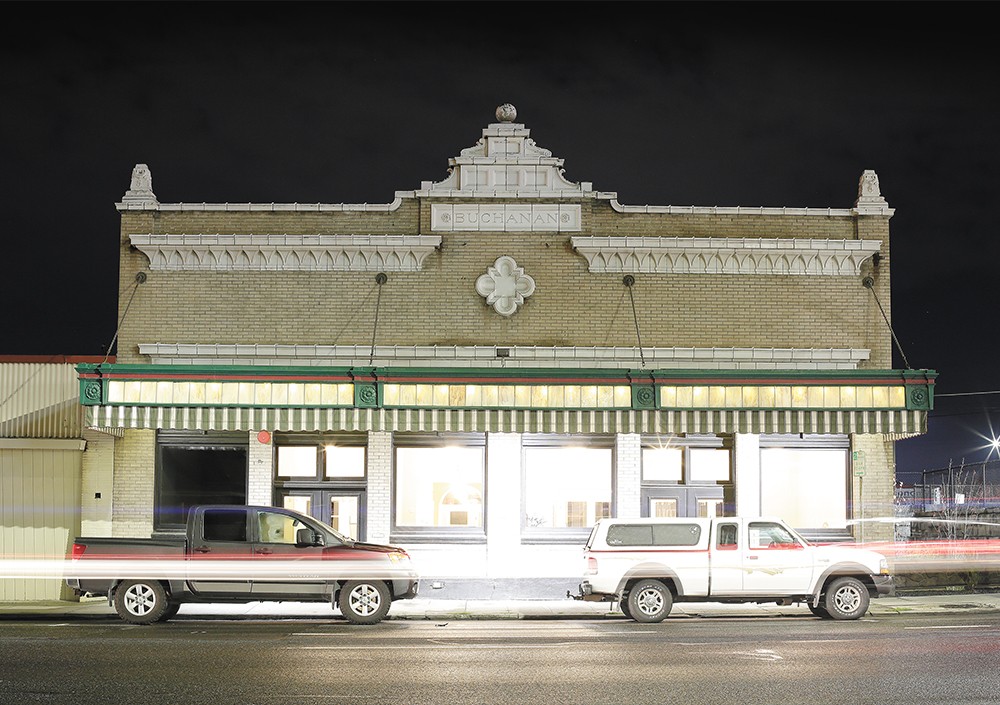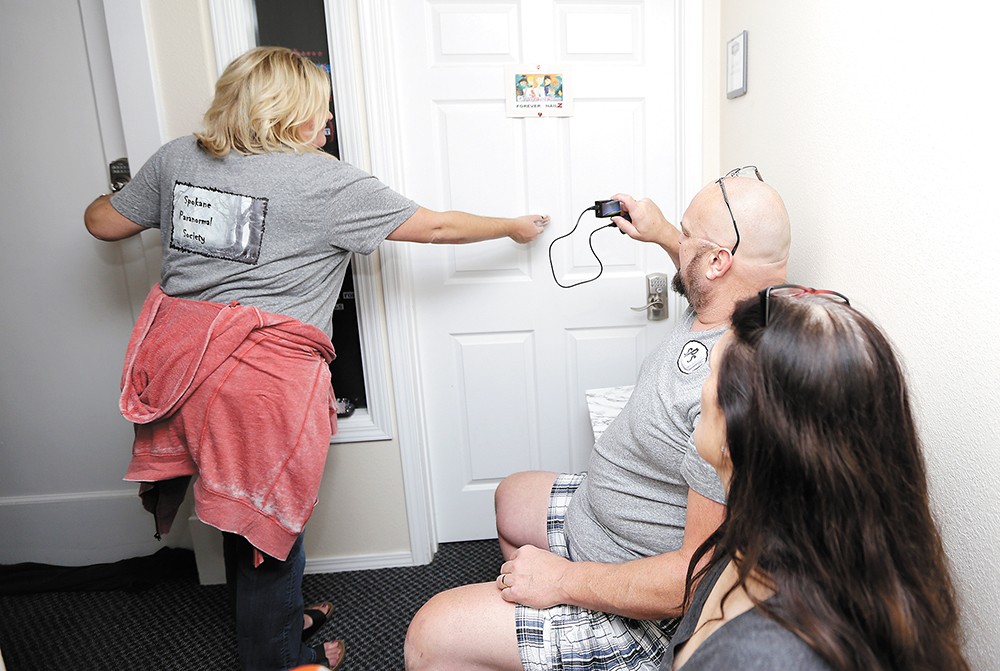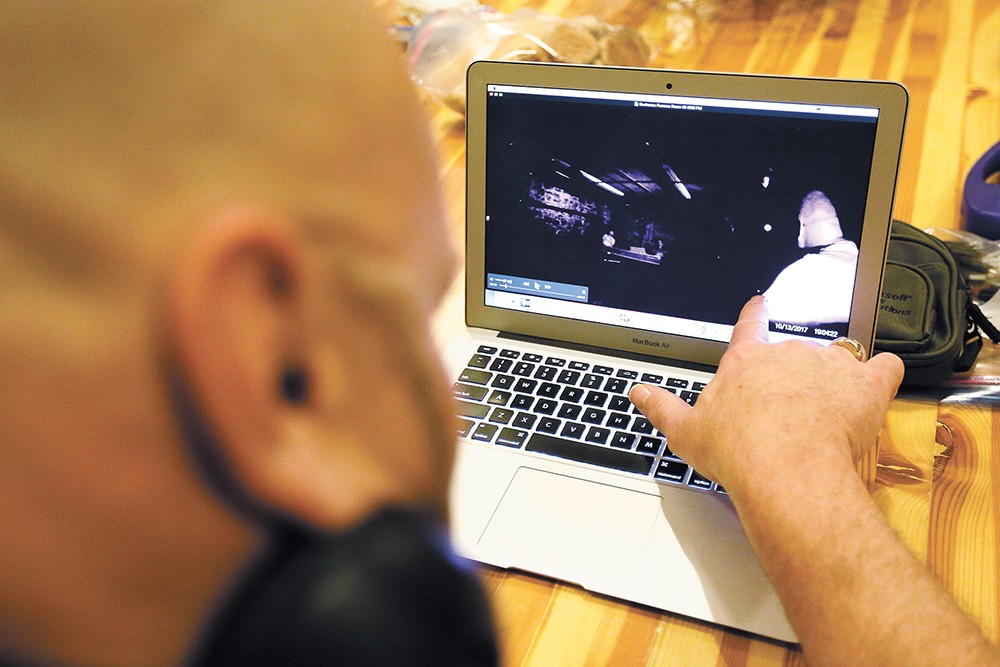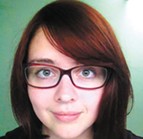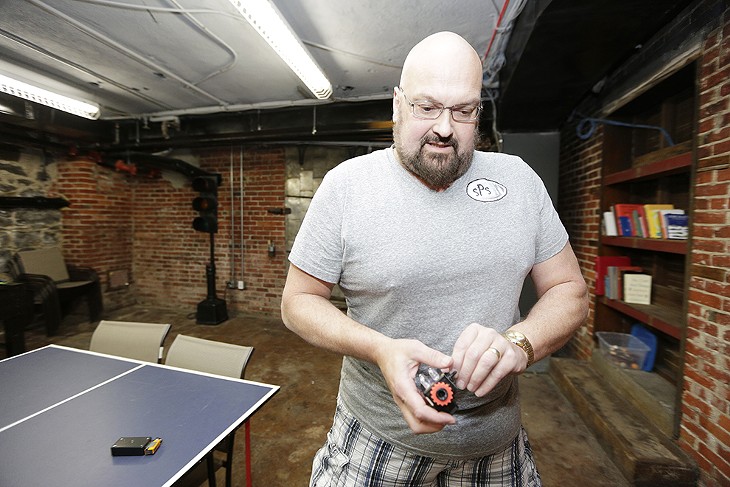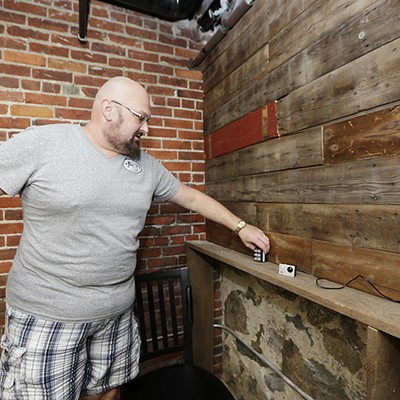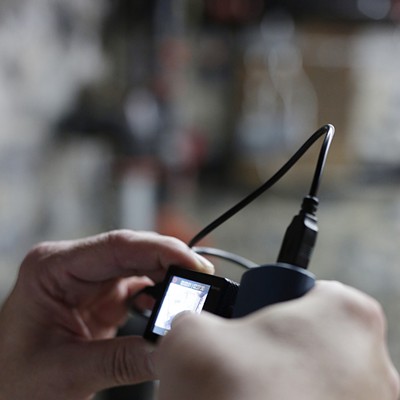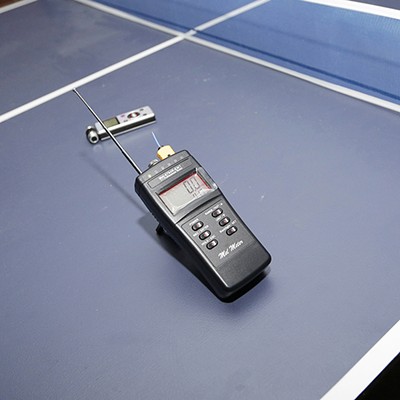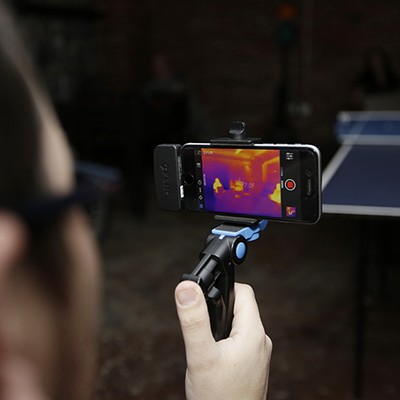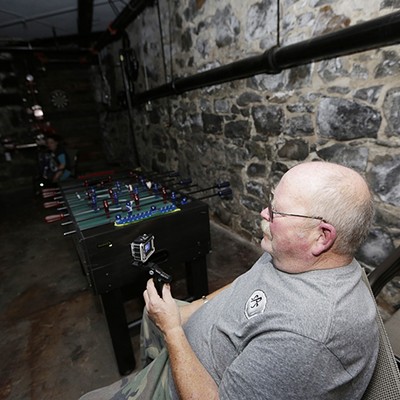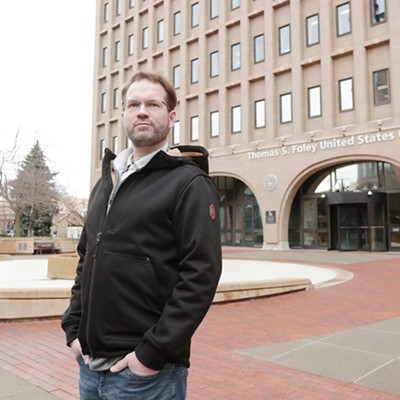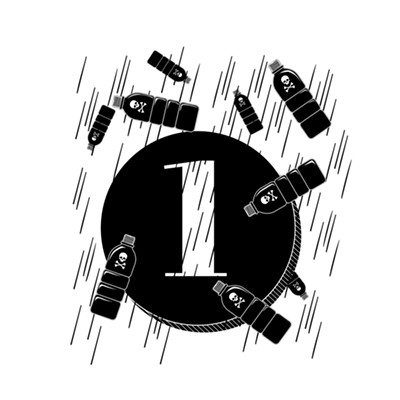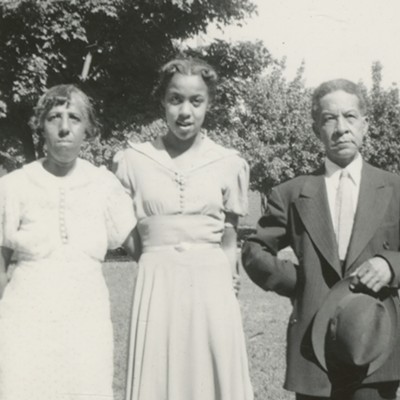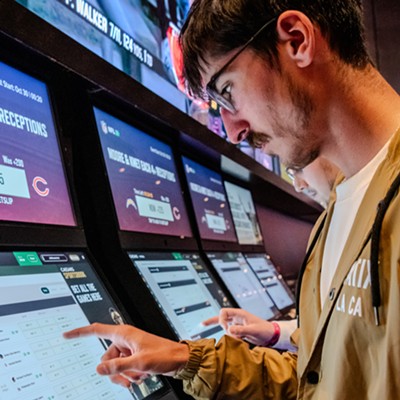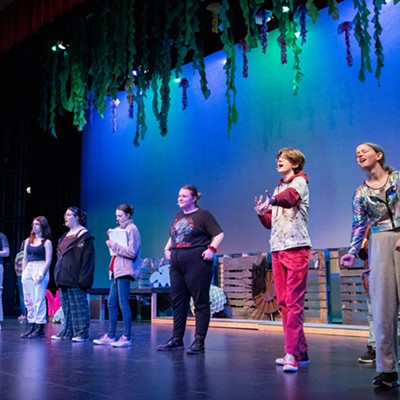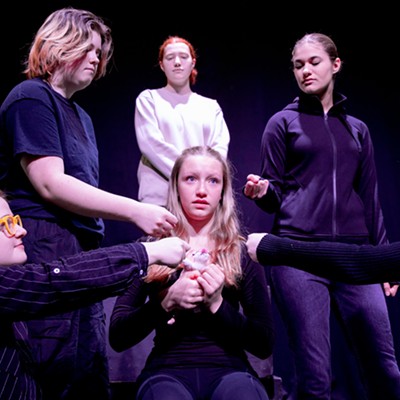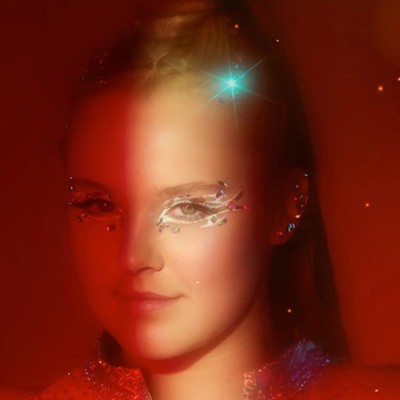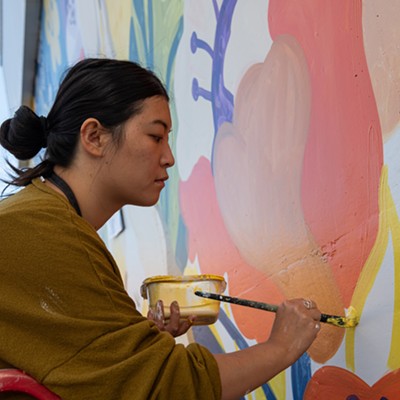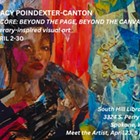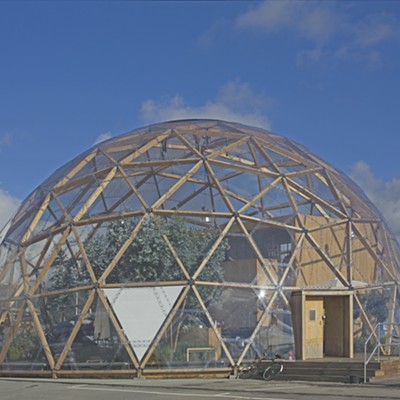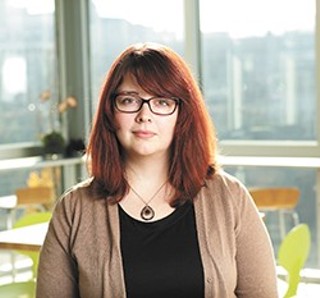It's almost too perfect. On a rainy October evening — Friday the 13th, no less — a big, wooden door squeals with the theatrical flair of a stage actor, overdramatically creaking as it opens to a space where Spokane families came to view their dead a century ago.
The room is dark during our visit, except for the green and blue light from gadgets and infrared cameras illuminating the faces of three ghost hunters with the Spokane Paranormal Society.
You'd never know it now, but for decades, this room in the Buchanan Building on Third Avenue was used in one of the city's only funeral homes. Bottles of embalming fluid and caskets have since been replaced with computers, Nerf guns and the modern furnishings of the 21st-century tech company that operates here.
It was in this very office two years ago when the ghost-hunting team captured its first "conversation" with some... thing. Video footage from that night shows a flashlight with the cap just barely unscrewed hesitantly turning on and off over the course of a few minutes, seemingly in response to questions spoken aloud in the room. They hope to repeat those findings tonight.
"What can you do, to let us know you're here?" asks Mark Porter, who co-founded the supernatural team with his friend Ray Lusk.
All of us silently wait and watch, keeping our eyes and ears peeled for an answer. It's getting late now, and most of us are starting to yawn.
"The very first time I was in here, over two years ago, I heard faint pipe organ music," Porter says to no one in particular. "Can you do that again?"
Seconds later, a loud crash sounds behind us. We jump in our seats and gasp. What was that?! No one, not even a skeptical reporter, has a good explanation, and eventually the team packs up to leave — not with evidence of anything, but yet another moment they can't explain.
These paranormal investigators aren't alone, though. Indeed, ghost stories transcend religions, cultures and countries, dating back to early civilization. Modern technology has changed the nature of the search, but the fundamental questions remain the same. What happens when the lights go out? When our loved ones die? When we hear knocking and no one is there?
For people like Charles Johnson, who investigates the paranormal with the Spokane Ghost Crew and identifies as Christian, the search has an undeniable draw.
"I guess, [it's] hope that there is life after death, that death is not the end," Johnson says. "I have full faith there is. But, I mean, the human part wants scientific proof. I don't know if that's possible. But I guess I'm here trying."
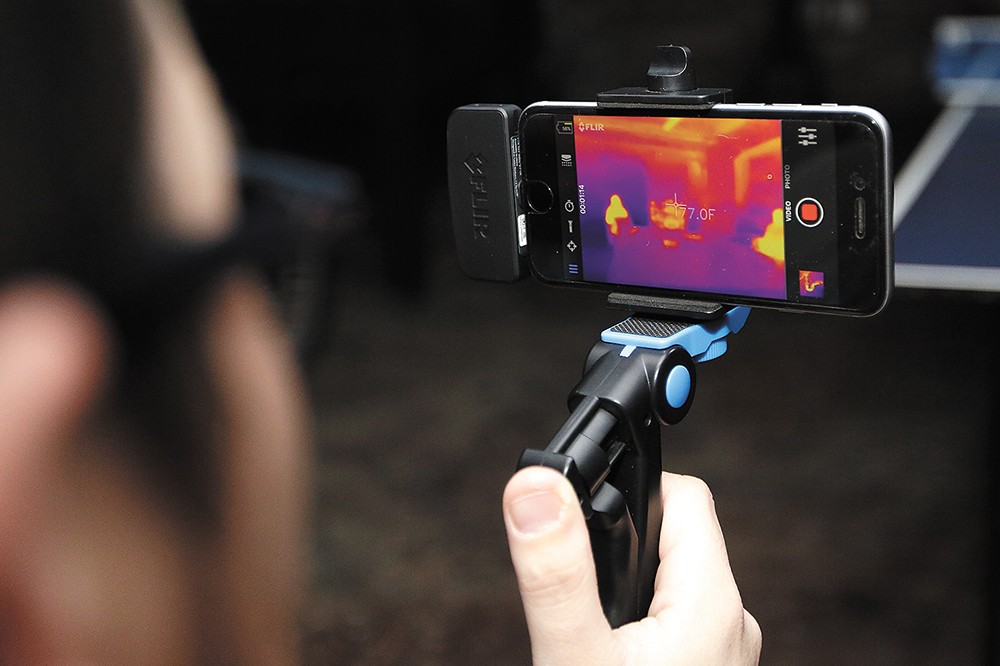
For millennia, people have believed in and wanted to prove that there is an afterlife — that the essence of who we are might just survive the separation from our earthly bodies.
The belief goes back even as far as Neanderthals, who buried objects along with bodies, says Justin McDaniel, a professor who teaches religious studies at the University of Pennsylvania. McDaniel helped found the Penn Ghost Project, an interdisciplinary group that studies why people believe in ghosts and what impacts those beliefs have on day-to-day life.
"Why would you bury something valuable with somebody if they can't use it after death?" McDaniel asks.
Spirits show up in texts throughout history, from the ghost of Hamlet's father, who appears again and again in Shakespeare's play, written around 1600 AD, all the way back to the ancient Mesopotamian ghost of Enkidu, searched for in the underworld by his friend, the namesake king in the Epic of Gilgamesh, written around 2100 BC.
Both bad and good ghosts are referenced across cultures, and in America and Western society, we particularly tend to separate the term "ghost" from spirits or angels, McDaniel says. That's even been reflected in changes to how the Catholic Church references the Holy Trinity.
"When I was growing up, it was 'Father, Son, and Holy Ghost,' but now it's 'Holy Spirit,'" says McDaniel, who attends Catholic church. "In pop culture it's coming to mean something malevolent — unless it's Casper the friendly ghost — while spirits are beneficial."
According to the group Catholic Answers, it also has a lot to do with translation to English, with "ghost" coming from German, and "spirit" coming from Latin.
Every major religion references spirits of the dead and an afterlife or spirit world. Some even describe what sounds a lot like the modern-day conception of ghosts. Islamic texts reference the "jinn" (a single jinn can also be called a "genie"), supernatural beings that live on Earth and can both be invisible to people and physically interact with the world we live in. The term can refer to angels or more malevolent beings.
"Why would you bury something valuable with somebody if they can't use it after death?"
tweet this
There's no single answer to where the belief in ghosts, spirits or the afterlife originates, says McDaniel, who has extensively studied and written about the importance of ghosts in Thai Buddhism, where it is believed that ghosts may help people heal and overcome obstacles.
While many people believe in an afterlife as part of their faith, it may be that some people need to believe: One theory suggests it's a psychological coping mechanism, McDaniel says.
"It's hard to say I'll only live for 70 to 90 years and that's it," he says.
Cultural pressures play a role too, McDaniel says, as people grow up surrounded by particular religious beliefs and practices that may be as much about the social and economic benefit as they are about belief. And belief makes for better storytelling.
"Life is relatively predictable. For most people, you go through a series of waking up, going to sleep, eating and going to the bathroom," McDaniel says. "We have arbitrary markers along the way: 50th birthdays and 16th birthdays, anniversaries and celebrations. Maybe having a story of God or Buddha is just a better story — it makes life more interesting."
Aside from one's personal faith, McDaniel says, belief in an afterlife may even serve our species well from an evolutionary standpoint, driving us to build things that outlast our lifespan.
In some ways, modern American ghost hunting's roots can be traced back to the Victorian era of the 1800s, when spiritualism came into vogue during the years surrounding the Civil War. Many hoping for one more contact with the dead, taken too soon by the violence, held séances, heeding the advice of mediums, many of whom later admitted they lied or were exposed as frauds.
But that didn't stop the fad from catching on with prominent figures. Mary Todd Lincoln reportedly held numerous séances with mediums in the White House in hopes of speaking with her son Willie, who died as a child.
With the advent of the camera that same century, people obsessed over photos that seemed to show spirits. Much of this "evidence" of spirits was later disproved: When shutters were open for long periods of time, a partial exposure of someone could appear ghost-like. The famous showman P.T. Barnum helped disprove the claims of "spirit photographer" William Mumler, who traveled the country supposedly capturing pictures of people with their dead loved ones. Barnum showed that these could easily be faked with double exposure and an older picture of the relative, or a living stand-in.
Later, after the invention of the telephone, even Thomas Edison was interested in finding a way to contact the spirit world and record it.
Linking the new technology with spirits is not that far-fetched if you think about how spooky the very first recorded voices must have sounded to people. How magical it must have seemed that a physical material could capture someone and replay their words forever?
Just like their Victorian predecessors, many modern ghost hunters turn to the latest technology to help them in their search.
I got a spike over here. It just went into the yellow as I walked over here," Brian McCraw tells Checkerboard Bar owner Ian Maye, holding up an electromagnetic field or EMF detector in a corner of the empty Sprague Avenue bar, closed for the night.
"Red!" Maye says, holding a cellphone broadcasting this investigation live on the Spokane Ghost Crew Facebook page. "It's just gone to solid red."
"I think I got your problem here," McCraw says after a moment, holding the detector up to a device on the wall. "It's a haunted jukebox."
This is fairly common in modern ghost hunting. While it's believed by many investigators that ghosts or spirits can manifest in or manipulate electricity, a lot of other things can also set off their detection equipment.
On this mid-August night, as the crew searches for evidence of a ghost that reportedly has a thing for blonde bar patrons, they use equipment common among investigation groups.
There are infrared and night vision cameras, and an additional infrared light to help illuminate the space for that footage. Recorders run in the hopes of catching electronic voice phenomena, where phrases not heard in the moment are sometimes captured via audio. Later they'll pull out a "spirit box" that rapidly scans radio frequencies, occasionally offering the snippet of a word or phrase.
McCraw asks the ghost to make himself known by tapping on something, or turning on pieces of equipment. He asks if the ghost can finish his knock, rapping the ba-duh-duh-duh-da of "shave and a haircut" on the bar with his knuckles, waiting for the two knocks of "two bits" that never come.
After a time, ghost crew investigator and technician Trevor Gouge sets up a motion detector that makes a shrill beep at the slightest movement, and we clear out to the back patio of the bar, waiting to see if the equipment might catch anything while we're outside.
Just as McCraw, the last one to leave, is a few steps from the door, something crashes inside.
"What was that?" Gouge asks. "I could see all of you and I know that wasn't you."
"What the hell?" McCraw says.
Inside, the culprit is found: a metal flashlight had fallen from the bar to the ground. This is another common tool that ghost hunters believe can help with communication. Turn the flashlight on, unscrew the cap until the light is just off, then leave it sitting out as you ask questions and direct a spirit to turn it on or off.
After debating whether the flashlight rolled off due to gravity or was pushed, the team resumes asking questions. Investigations often involve hours of this, which is most often met with silence.
"Sometimes it seems like there's absolutely nothing," Gouge says, after McCraw asks yet another question that remains unanswered. "Then we'll go over the recorders and find we've got responses and answers."
McCraw says he started the Spokane Ghost Crew in 2014 mostly because he wants to help people. He's brought on several members to the team, most of whom are relatives or close friends.
"I want to help people explain the paranormal," he says. "I want to be able to show them what they have, whether it be a loved one, a spirit of somebody that died tragically in their house, or whatever it is, and try to help them to the best of my abilities."
Neither the Spokane Ghost Crew nor the Spokane Paranormal Society ever charge people for their investigations — usually led by six or seven people at most — and they all say to be wary of anyone who would.
Both teams say they have helped people whose homes have been haunted by demons or bad spirits that entered the home through "portals" that, they say, are most commonly left open by someone playing with a Ouija board and not properly saying goodbye.
At some level, they all want their recordings to pass muster when they put them out in the world, so they try to debunk them themselves throughout their process before others do it for them.
Whether anyone can prove ghosts exist or not, the widely held belief in spirits has a noticeable impact on daily life, says McDaniel, the religion studies professor. Think about how hard it can be to sell a home where someone was murdered: Whether someone will admit they think it could be haunted afterward or not, they'll likely choose a similar house without that history if they can, he says.
In particular, the desire to spend hours probing something that likely isn't answerable is part of what intrigues the Penn Ghost Project team, he says.
"That's what's fascinating to us," McDaniel says. "Just as somebody would take up a sport, or painting, or music, that they would take up pursuing something we can't prove."
In fact, many of the ghost hunters his team has spoken with admit that they act even in the absence of proof and knowingly do so, yet many still believe.
But it's hardly different from a lot of other choices we make, McDaniel says.
"People can pour emotions into things that, in a sense, they know have no real rational impact on their life," he says. "Your favorite character in a TV show can die and your life will be exactly the same the next day. But you'll be emotionally wrecked by it. How is that different from believing in ghosts? It feels true to you."
Tales and experiences of spirits are extremely common. Among U.S. adults, 41 percent believe in ghosts, and 64 percent believe the soul survives after death, according to a 2016 Harris Poll.
The feeling that we get — that something else is in the room with us — has a lot to do with our biology, and the way our brains work, explains Michael Shermer, creator of Skeptic magazine and the author of several books on how our brains want to believe in things like ghosts. It's beneficial for our brains to make patterns out of the things we see and hear, not only for communication with other people, but for survival.
"The problem is this: that the mind is designed to find patterns whether they're there or not," Shermer says. "I call that patternicity: the need to find patterns in random noise."
An example might be looking at a cloud and seeing a dragon, or seeing a human-like face in an inanimate object, such as an electrical outlet. The theory is that this type of thinking — giving human traits or agency to even inanimate objects — helped us survive. Imagine you're out in the wilderness and you hear something nearby in the grass, Shermer says. It could be the wind, or it could be something out to get you.
"It's less costly to make a false positive, where you thought it was a predator but it was the wind. If you make the other type of error, you're lunch," Shermer says. "It's more likely to leave us a legacy of brains that are constructively paranoid."
Along those lines, people who want to believe aren't stupid, uneducated or uncultured, he says.
"When you have an anomaly that you can't explain, we also have something of a propensity to fill in the gap," Shermer says. "Explanations of any kind feel better than no explanation. ... Most people are uncomfortable with uncertainty."
Even skeptics like Shermer have things happen that can make them question everything they believe. When Shermer's then soon-to-be wife moved in with him, she had an old radio that belonged to her grandfather, who was the closest she had to a father figure and died when she was a teenager. Shermer tried to fix the radio, but nothing seemed to work.
Then, on the day of their wedding, performed in a small ceremony at the home, they heard music coming from somewhere, and after searching all over, pulled the radio out of a drawer, where it was playing romantic music.
"It came on and played this romantic music all day and night, and then went dead again," Shermer says. "What do you make of that? Maybe it was an emotionally meaningful connection and that's enough. That's OK. An anomalous experience happened. We take from it what we wish, but that doesn't prove anything."
for the Spokane Paranormal Society's Natalie Quinn, who mostly gets dragged along to explore possible ghost sites around Eastern Washington and Canada with her longtime friend Mark Porter, the search is not so much about finding proof.
"I wouldn't say I want answers, I'm just intrigued," Quinn says. "I like the nervous feeling it gives me in my stomach. ... When something does happen, you just get that excitement, the thrill of the chase."
Both Quinn and Porter say they do it because they want to help people. Neither is able to work due to injury or disability, so the roughly monthly trips give them the chance to socialize and get out of the house.
"This is a passion for us, it's not an obsession," Porter says.
But Porter does feel that the search gives him some answers to the universal question of what happens after you die.
"I think it's kind of soothing," he says. "We've proved you don't just become worm food."
In his mind, the afterlife is what you make it.
"If you want to make it a nice happy place, you certainly can," he says. "If you want to make it a place to dwell on your past failures, you certainly can. I think some of the people who are stuck are still dwelling on those failures and 'I was wronged,' and 'I messed this up,' and 'How do I get it back and redo it?' I think they're people who dwell with guilt instead of just get past it."
That's changed the way he lives.
"I think I'm more calm, I think I'm more mellow. I don't think I let things get to me nearly as much," Porter says. "I think I'm more level-headed from doing this, which is absolutely backwards of what you'd think of someone doing this. You think, 'Oh no, you're a nutjob. You're going to go off the deep end.' I think it's actually made me more level-headed and willing to look at things from more of a logical standpoint." ♦
GHOSTS AS CULTURAL CONTROL
Through history, superstition has both been adopted as mainstream and seen as threatening religious beliefs or societal control. In a way, belief in the supernatural simultaneously conflicts and conforms with religious dogma.
"Because we live in an age of science, there's a need we have for evidence," says Michael Shermer, creator of Skeptic magazine and the author of several books on how our brains want to believe in things like ghosts. "In the Middle Ages, there was pushback against scientists skeptical of witches, because if there's no witches maybe there's no demons, and if there's no demons, maybe there's no God."
In 1930s China, on the other hand, it was hard to sell the idea of socialism and the plight of the working man to rural people who already had their own ceremonies, ghosts and superstitions to look to, explains Laikwan Pang in her article, "The state against ghosts: a genealogy of China's film censorship policy." Some traditional folklore and ghost stories were allowed as the state gained rural support, but the concepts were also seen as a threat to communism and became censored over time.
Though censorship policies have fluctuated, and ghosts have mostly been allowed in theater, TV and books, Pang explains, to this day, Chinese censors won't allow most ghost stories in movies, unless they are explained at the end in a logical way, often by attributing the gore and horror to the delusions or thoughts inside the mind of a psychotic person.
"Culture in general, and film in particular, has always been broadly understood as a powerful tool for reflecting and manipulating people's thoughts and values, and the state has always assumed the role of cinema's guardian," Pang writes. "In the tug-of-war between politics and culture, the Chinese government has never been totally able to control its popular culture. Contemporary Chinese cinema does not present ghosts, but people's fascination with them can easily be fulfilled by imports."
SPOOKY ENCOUNTERS
Awakened in the night by a friend, one Inlander reader says they were shown through their friend's eyes how his car went out of control and slammed into a tree. The next day they received a call: The friend had been killed in a car accident the night before. Read more about this and other chilling tales from local readers online at Inlander.com.
ABOUT THE AUTHOR
Samantha Wohlfeil joined the Inlander as a staff writer in February 2017, following more than three years as a reporter at the Bellingham Herald. She's walked graveyards, explored abandoned buildings and pondered the inevitability of death, and regardless of whether our souls live on after we die, she thinks it's a pretty good idea to live the best life we can while we're here. Reach her at 509-325-0634 ext. 234 or [email protected].

